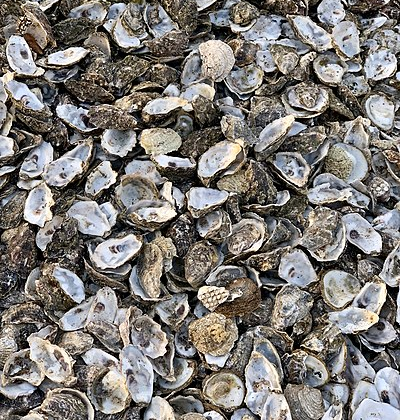
According to Robert Browning, “a man’s reach should exceed his grasp.” When it comes to what humans can achieve versus what we can handle, we seem to have met Browning’s expectation. When the Deep Horizon oil spill happened in 2010, it was revealed to the public that what had been built was knowingly beyond our ability to repair. Everything hinged on hoping a disaster would not occur. That is “on trend” these days, but we have ways of hiding the truth from ourselves.
One way that we hide hard realities is by pretending that nearly everything can be turned into or made from something else. So many products these days are made from the unexpected. Long Wharf Supply Company sells sweaters made from “recycled oyster shells, recycled water bottles, and natural lambswool or cotton.” They are not the only company working with oyster shells. All kinds of things are made from recycled plastic bottles, including stuffed animals, and new plastic water bottles. You can make plastic from seaweed. We are all familiar with almond milk and oat milk and cashew milk, etc. We have “meatless” meat. “Beanless coffee” is on the horizon. Many of these efforts are in good faith, but they still sometimes stop us from confronting the truth.
One truth is, we produce massive amounts of waste each year, for things which matter not at all. Yes, there’s fast fashion. But there are also the toys in kids’ meals. And there are the medals you get for completing a 5K (everyone says kids shouldn’t get participation medals, but adults collect them). And it’s true that you can buy some things made from plastic, but most of the plastic you put in the recycling bin doesn’t get recycled. Most plastic recycling is a ruse. The situation is such that people refer to plastic recycling as a “myth.” You may see a number and a triangle on the bottom of a piece of plastic, but it may mean nothing. Only 5-6% of plastic is recycled in the United States, something the companies don’t mind keeping quiet.
The handful of products that take what seems to be waste and turn it into something valuable are not reflective of general trends. It may be 2024, but not everything can be turned into something else. Not everything can be made from just anything. We do not have a complete plan for all the things we are doing. We are moving ahead with electric vehicles, without sufficient plans for how to recycle the batteries, for example. We are running out of helium, but we keep using it for birthday party balloons.
We can pause and examine the situation without becoming Malthusian. There is a difference between believing in innovation and blithely ignoring what is happening around us. But the question isn’t just what kind of future we want, but what kind of present? Would I rather have clothes made from water bottles or cotton? Do we want to be making so many water bottles that we have to find new ways to transform them into more and more of our goods—or is the fact that plastics are already in our brains a satiation point?
We can prioritize the real for the present, with or without invoking the future. Being more honest with ourselves about what we buy and make and how we operate—with or without healthy limits—is good for us, not just our grandchildren. And the more real things there are around us and the more able we are to acknowledge their permanency, the more we can appreciate things and understand our relationship to them.
The truth is, a plastic kids’ meal toy has more object permanence in its current form, on this Earth, than you do in your current form. We laugh about plastic straws, but they outlive us. It takes them about 200 years to decompose after use. You must legally be buried or preserved within a certain number of days after your death. Pretending that everything around us is as temporary as we are or that everything is easily transformed is a false way of relating to the temporal. It is a bad way of coping with our own impermanence. We do not want to acknowledge non-renewable resources because we cannot imagine our own ends. We are not just hiding the truth, we are hiding from the truth.
When it comes to what humans make and attempt with technology, we are ambitious but we are also afraid to look directly into the light. We prefer Plato’s cave and its shadows. We forget that its inhabitants are chained.
Image credit: Y.ssk / Wikimedia Commons / CC BY-SA 4.0
